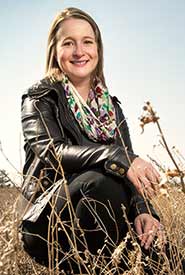Nature therapy (part four): Homeschooling in nature
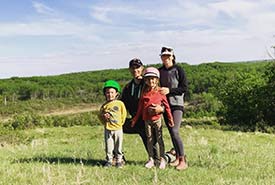
The Sandersons are a nature-loving family (Photo courtesy of Amy Sanderson)
As engagement manager, I have the great privilege of exploring Saskatchewan and meeting many new people along the way. Every Conservation Volunteer holds a special place in my heart, and getting to know them and learn from them is one the best parts of my job. Some volunteers have become my friends. One of these people is Amy Sanderson, who lives in Lumsden, Saskatchewan, with her husband and two adorable, smart and kind children — Maddy and Finn, seven and five years old, respectively.
Related content:
I first met the Sandersons, who are also Property Watch volunteers, last summer at a milkweed planting event at our Big Valley property. Amy and I have kept in touch ever since. Along with her genuine passion to be a steward of the land and an environmental advocate, I am constantly inspired by her to incorporate more nature into my daily life with my own daughter.
The Sandersons are a homeschooling family. Although this form of education may not be for everyone, Amy and her family are truly an inspiration in incorporating lessons from nature into your daily lives, regardless of age or familial status.
Kayla Burak (KB): What inspired you to homeschool your children?
Amy Sanderson (AS): Prior to having children, my husband and I hadn’t considered homeschooling. Upon having children, we decided that we wanted to be able to stay home with them, so we took turns working. Preschool time rolled around and we did that at home along with play dates, story times, craft times and nature adventures. They were learning a lot and we were able to provide one-on-one individualized education. We tried kindergarten at home with my daughter, starting at four years old, and realized that we were going to homeschool for the long term. It was just a natural extension of living and parenting, and we could cater to their strengths, weaknesses and interests while spending lots of quality time together as a family.
KB: What parts of homeschooling do you enjoy the most?
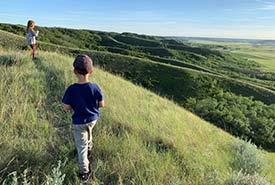
Maddy and Finn enjoying the vista on a hill (Photo by Amy Sanderson)
AS: Homeschooling has been such a wonderful experience, with us as parents learning just as much as our children. We really enjoy the fact that the whole world is our classroom. We follow the natural rhythms of the day, season and year, and most of our learning is engaging and hands on. We’re able to do field trips many times a week and when the weather is beautiful, we head out adventuring! Homeschooling for us is equivalent to living a curious life and being lifelong learners.
KB: Can you give a few examples of resources that you have found useful?
AS: Nature and the library are our two most inspiring and useful resources. Our children will ask a question and we will ask back, “Where could we learn more about that?” We brainstorm how we can answer these questions, which makes the ability to learn and gather resources just as important as the learning itself. We will watch videos or search the internet and, if possible, we will search it out in person by going out into nature and observing plants and animals and ecosystems. We also enjoy volunteering for organizations such as the Nature Conservancy of Canada. Our learning resources have been limitless!
KB: Can you explain why is it so important to you to have nature be such an integral part of your children’s learning and your family’s core values?
AS: By experiencing nature in a continuous and in-depth way, we begin understanding our role, contribution to and impact on our ecosystem, world and universe. David Attenborough explains it very well in his quote: “No one will protect what they don’t care about; and no one will care about what they have never experienced.” By experiencing and being immersed in nature, it is clear that we are part of nature and have a responsibility as a species to be stewards. So, we learn to only take what we need and how our lifestyle and choices directly impact nature. Our children can see these linkages and have a great respect for our environment and are very aware of the impact of their choices — in both positive and negative ways.
We also believe that nature is healing — physically by moving our bodies as well as emotionally — since nature does not judge and can be an incredible teacher if you sit still for a while and observe. Nature also shows the cyclical beauty of life. Seasons come and go in this reassuring cycle; spring comes after a long winter, flowers bloom gloriously for a short period of time, trees shed their leaves and eventually die and nourish the next generation of beings in that ecosystem. As you observe nature and its rhythms, there is such comfort in understanding our humanness — our times of growth and blooming with the equivalent need for rest.
KB: Can you give a few examples of nature-based activities/teachings that you have done with your kids this summer?
AS: Each year we learn about plants and their life cycle by planting, tending and harvesting a garden. Our kids looked through seed catalogues and the seeds we had saved from the year prior and planned their own garden box. They added compost from our compost bins then planted the seeds. They’ve been tending their gardens and observing the growth, pollinators, insects and birds that like to frequent the gardens.
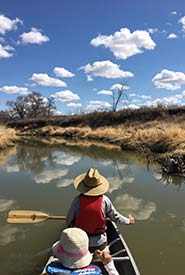
The Sandersons take a paddle in their canoe (Photo by Amy Sanderson)
We have many favourite hiking spots near our community, including the Big Valley and Valley View Nature Conservancy of Canada properties. The kids have enjoyed observing the changing seasons, playing in the creeks, slopping through mud in spring and watching the plants grow and bloom. We also enjoy biking and viewing wildlife in our backyard and everywhere we adventure. We also really enjoy canoeing and have the Qu’Appelle River and Wascana Creek close to our home. This year we have observed birds, frogs, turtles, muskrat, deer and beavers from our canoe.
KB: What do your kids enjoy most about being in nature?
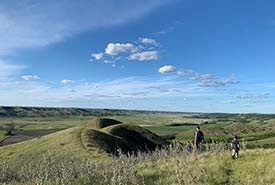
The Sandersons have several favourite hiking spots near their community, including NCC properties. (Photo by Amy Sanderson)
AS: They said that they enjoy exploring new places, seeing animals, bike riding, playing in the water and having fun with friends and family. From my perspective, there is a massive freedom when our children explore the outdoors. There is no agenda. Everything is interesting; from the tiny insects to the flowers, to the birds flying overhead. They become immersed in the sounds, sights and smells of nature. It’s a mindful, present state. Nature is so calming and grounding.
KB: What would you say to help inspire to someone who is thinking about incorporating more nature into their lives?
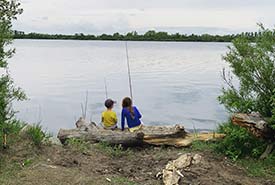
Maddy and Finn fishing by the shore (Photo by Amy Sanderson)
AS: In nature, you are free to enjoy and be yourself. You’re engaged in the beauty around you and there are surprises everywhere — a blooming flower, a bird circling above, a deer grazing in the meadow, fish jumping in the water, the leaves crunching below your feet or snowflakes floating down. So start close to home. Nature is very healing and enjoyable. Hang a bird feeder in the cold months of winter and observe the variety of birds over wintering; it gives us an appreciation for our warm homes and food on the table. If you’re having a tough day or moment, simply go outside to sit and watch the birds, or go for a walk. Nature gives us a bigger picture; it lures us outside of our thoughts and responsibilities and lets us rest and enjoy the moment. Nature brings gratitude, relaxation and enjoyment. There is a calm and happiness that comes with being in nature — it is immediate.

